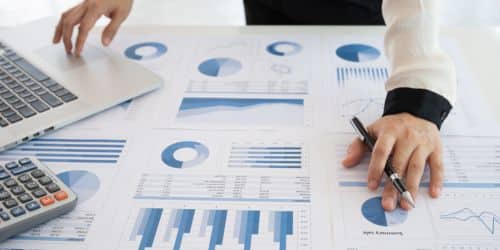Financial forecasting is a process that businesses use to plan for the future. Forecasting is all about trying to guess how things will turn out in the future. In the end, a good financial forecast can save money, make budgeting easier, and open up more educational opportunities. This article talks about the forecasting software and examples of how to do a financial forecasting model.
Overview
Financial forecasting is all about making estimates or projections about how a business will do in the future. Even though forecasts for the income statement are the most common, a full financial model will include forecasts for all three financial statements.
The goal of a company’s financial projections is to make it easier to talk about the company’s goals and priorities in a way that makes sense to the company itself. With projections, a company can figure out what assets and debts it needs to meet its goals and priorities.
A common type of financial forecast is a sales forecast. Forecasting sales can help a company make other financial decisions that help it reach its goals since most accounts on a company’s financial statement are tied to sales or related to sales. But the costs of getting those extra sales would go up at the same rate as sales grew. Each prediction affects how much money the company makes in the end.
Forecasting could help the top people in a company understand what will happen to the business in the future. Financial modeling is used to figure out how much these projections will cost. Estimating future fixed and variable expenses as well as capital spending is another part of financial forecasting. Predictions are made based on how things have gone in the past. They can help you figure out what might happen next. Businesses and entrepreneurs use financial forecasting to plan how to use their resources and figure out how much it will cost them in the future.
Financial Forecasting Model
Using a financial forecasting model, businesses might be able to see what will happen in the future. There are many different financial forecasting models, and the one that works best for you will depend on the events you want to predict, the data you have, and how accurate you want your predictions to be.
To get better at analytics, you need to know when and how to use different forecasting models. The best financial model changes depending on what data is available, what the goal of the analysis is, and how much uncertainty there is. The following are some tools for a financial forecasting model that can help you plan for your company’s future.
#1. Top-Down Models for Predicting the Economy
This model can help you evaluate a new idea when you don’t have enough information from the past. A top-down financial forecasting model, which starts with the size of the market, can help you figure out how much of the new market your company will be able to capture.
#2. Forecasting Models From Delphi
The Delphi method takes the collective knowledge of a group of experts and uses a facilitator to test and improve ideas and analyses over and over again until a consensus is reached. This cycle is based on methods like questionnaires, surveys, and focus groups, and each iteration is better than the last. This is a good way to make sure that everyone in the group can see all the information.
#3. Bottom-up Model for Making Financial Forecasts
Bottom-up forecasting makes sense if you have sales or financial records from the past. Then, to predict what will happen, you plug in your current sales numbers and cash flow statements. This method usually gives more reliable results because it uses real data instead of hypothetical examples.
Financial Forecasting Examples
The following financial forecasting model examples are below:
A financial forecast is an estimate of how the company’s finances are likely to change in the future. “This is how our company is likely to grow in the future,” you said, based on your predictions. Find out what assets you have before you get too comfortable making financial plans or projections. Analysts can look at both internal and external metrics, such as how well a company has done in the past or how the market is changing. Because of this, these things will affect how well you can predict your finances.
#1. As an example, Look at Sales Projections
The sales forecast is used to figure out how much money will be made. Typically, product lines, customer types, or periods set it up. If you want your estimate of revenue to be accurate and useful, it needs to be based on good market research, including a look at the products and services that your competitors offer.
Before you start, you should also think about how you will sell your goods and how much you will charge. Financial forecasting is the process of making financial statements based on what is expected to happen. This kind of statement is also called a “pro-forma statement.” When making economic forecasts, assumptions are very important. Among these are:
- Statement of Earnings.
- Cash Flow Indicator.
- Preliminary financial statement.
When you fill out some of these forms, it’s important to do things in the right order. The profit and loss statement, which is also called the income statement, shows how much money comes into and goes out of a business. The cash flow statement shows how profitable a business is. With the help of the balance sheet, you can figure out what your future debts, assets, and equity will be. When these documents are accurate and complete, a business owner can plan for the company’s finances in the future.
#2. The Past Financial Forecast
By looking at your company’s past financial records, you can use historical forecasting to make educated guesses about how well it might do in the future. Here, you can look at the company’s financial reports (income, balance sheet, and cash flow). By looking at how the company did in the past, you can use these records to predict its growth in the coming years.
This method is good because it doesn’t take much time or training to use. Yet, because it is a quick method, historical forecasting leaves out important things like the size of the market and the number of strong competitors. This means you can’t use it to give investors a good idea of how your business will do financially.
#3. Research-Based Financial Forecast
If you want to make good predictions based on your research, you need to look at more than just the numbers on your bank statements. A well-researched projection will look at how the industry as a whole has done in the past. You also look into what predictions your competitors have made and compare them to your own. Financial advisors also think about how the business as a whole is growing, taking into account things like new consumer trends and technological advances and how they might affect the market.
How to Do Financial Forecasting
Here is a guide to planning and predicting money:
- Learn why this prediction is being made and what it might mean. Think about why you’re making the forecast, how accurate it needs to be, what factors could change it, and how much time and effort you’re willing to put into it.
- Choose the range of time for your forecast.
- Find a way to know for sure what will happen in the future.
- Set up regular “huddles” for your team to talk and share information. Forecasting methods that can look out for two or three months are better than those that only look out for one month.
- Write down your prediction and keep an eye on how it turns out. A key part of a cash flow projection report is projecting cash from operations based on the results of the forecast.
- Repeat as many times as you need to within the time frame you’ve set for your predictions, and then look at how well it worked.
Financial forecasting can help employees plan for the future and think about how they can make their work more efficient and effective to get better results. With this tool, everyone in the company can work better toward the same goal. A business can’t succeed without accurate projections of its cash flow. Still, many executives don’t do this step right. Financial problems could last for a long time if the organization has an unexpected need for cash that uses up all of its reserves. So, business leaders need to learn and keep up-to-date skills in financial forecasting.
Financial Forecasting Software
Using financial forecasting software, a company can estimate how much money it will make and how much it will spend for more than one division or section. The accuracy of budget planning is improved by getting rid of the room for error that comes with doing it by hand.
With the help of financial forecast software, you can guess how a certain part of your business will do financially in the future. Whether you run a subscription-based or software-as-a-service business, you can use this information as part of your larger financial model. The following are examples of some software that can help you make financial forecasting:
#1. Prophix
Prophix is a piece of Corporate Performance Management (CPM) software that helps you save time and money by automating boring tasks. The program has functions for budgeting, putting everything together, and reporting.
#2. Vena
The Vena platform brings together systems and data that already exist to make it easier to plan for the future of a business and predict its finances. Vena is an add-on for Excel that also has tools for planning and budgeting.
#3. Jirav
Jirav is a tool for business planning that has modules for budgeting, forecasting, reporting, and dashboards. Also, Jirav works best for companies with fewer than 500 employees.
#4. Float
Float is a way that Xero, Quickbooks Online, and FreeAgent can work together. Also, Float uses cash flow forecasting to make it simpler to plan graphical scenarios.
Pros of Making Financial Forecasts
The following are just a few examples of why a financial forecasting model is a good idea:
- Check the results to see if the activity is worthwhile and if it can be repeated.
- Sort out your finances and lead the business in the right direction.
- Give ways to measure how well future predictions work.
- When the economy isn’t sure, it’s important to have a plan B.
- Think about how the extra costs will affect your business.
- Find out where and what your money problems are coming from.
- Reduce financial losses and improve disaster recovery.
- Make things as stable and predictable as you can.
- Help with a lot of budgeting efforts in the future.
What Is the Point of Making a Financial Forecast?
Forecasting financial model examples is very important for the following reasons:
#1. Funds Flow
If you have a good handle on your cash flow, you can better manage your money and your business. Cash flow forecasting done right at the start of each accounting period will help you manage and keep enough cash flow to pay your bills. This is because you will have a clear idea of how much money you have, how much money you need, and how much money is coming in.
#2. Investing
When trying to get money, accurate financial projections are also very important. Investors evaluate a company’s financial statements and projections to see if it’s a good fit for their portfolio and investment objectives.
#3. Decision-Making
Financial forecasting models help management understand the company’s financial situation and make decisions, both right away and in the long run. You might be able to predict competition and changes in the market by looking at historical data and using what you’ve learned.
#4. Plans Getting Better
By comparing your predictions to what happened, you can track differences and make changes to your plan. If you want to run your business like a boss, you should look over the projections on the income statement, balance sheet, and statement of cash flows often.
What Are the Methods of Financial Forecasting?
The following are;
- Straight-line.
- Average difference.
- Simple regression along a straight line.
- Using several linear predictors to do a regression analysis.
What Is Financial Forecasting and Why It Is Important?
The term “financial forecasting” refers to the process of making predictions by looking at past financial data and current market trends. It is an important part of running a business because it helps people make better decisions in the future. To make accurate predictions, you need to use both numbers and your imagination.
What Are the Three Types of Forecasting?
There are three big groups: qualitative methods, analysis and projection of time series, and causal models.
What Are the Four Steps of Financial Forecasting?
Companies of all sizes need it because it helps them make decisions. They look at the situation and decide how the company should be set up for growth. The main parts of a financial forecast are the income statement, cash flow, balance sheet, and source of funds projections.
What Is the Main Goal of Financial Forecasting?
Financial forecasting looks at past, present, and future financial data and conditions to help make better strategic and policy decisions. A financial forecast is a model that sums up how the economy has been, is now, and will be in the future.
What Are the Three Purposes of Financial Forecasts?
Sort out your finances and lead the business in the right direction. Give ways to measure how well future predictions work. When the economy isn’t sure, it’s important to have a plan B. Think about how the extra costs will affect your business.
Conclusion
Investors use financial forecasting to figure out how outside factors might affect the stock price of a company. Using forecasts, some experts try to figure out what will happen to important numbers like the GDP and the unemployment rate in the future. The more time that goes by, the less accurate the forecast will be. The goal of a financial forecast is to predict how much money a company will make and spend in a given year.
- Demand Forecasting: Methods, Examples, Models (+ Detailed Guide)
- SALES FORECAST: Definition, Examples & Software Solutions
- Business Forecasting Definition, Methods, Examples, Types (Updated)
- Demand Planning: Overview, Comparisons, Salaries & Jobs
- What is Sales Forecasting? Methods and Real-world Examples
- UPGRADE CREDIT CARD: Free Tips, How to Do It, Limit & Review.






